
Rabbi Garelik Shares List of Pesach ‘Reminders’
Rabbi Levi Yitzchok Garelik, renowned author, lecturer and Rov, compiled a list of ‘reminders’ in connection with the laws and customs of the month of Nissan and the Yom Tov of Pesach, which he published on his website TheOnlineRabbi.com.
Presented below is parts 1 and 2, covering the month of Nissan until the first day of Chol Hamoed Pesach. Part 3, covering the rest of Pesach and the remainder of the month of Nissan, will be published as well when it becomes available.
For the Hebrew versions, click here and here.
Click on images below to enlarge the text

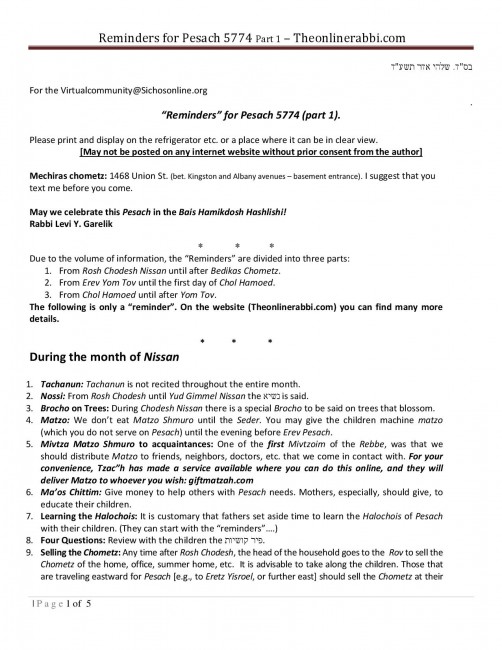
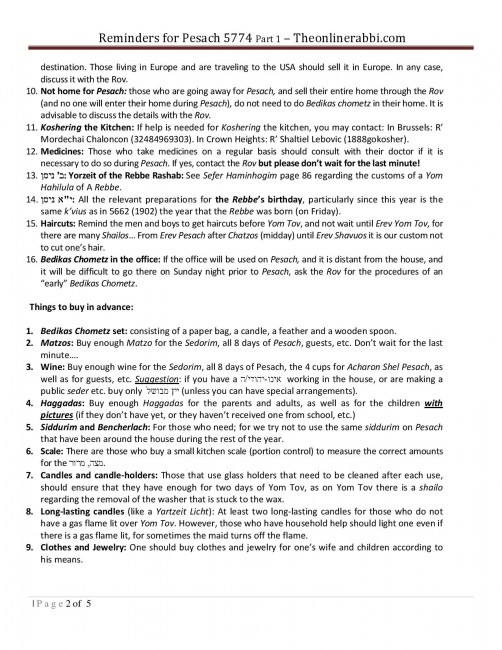

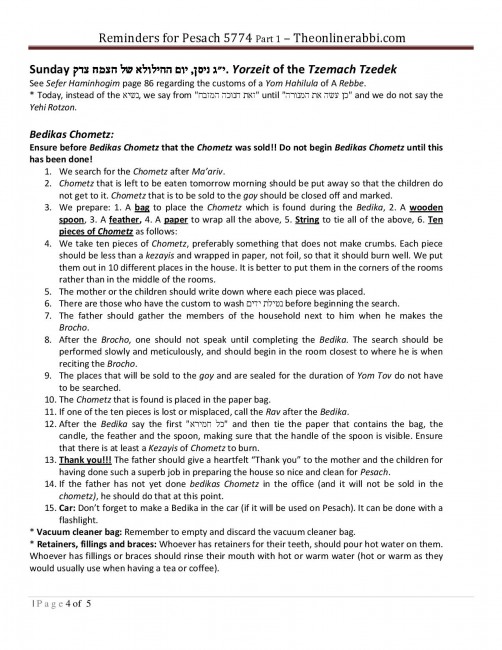

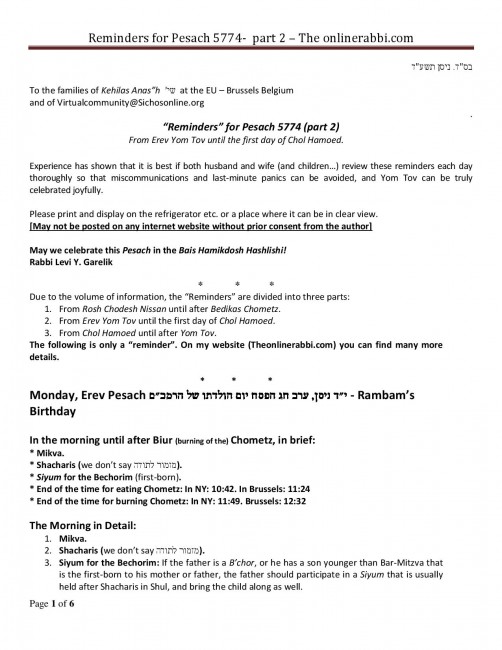
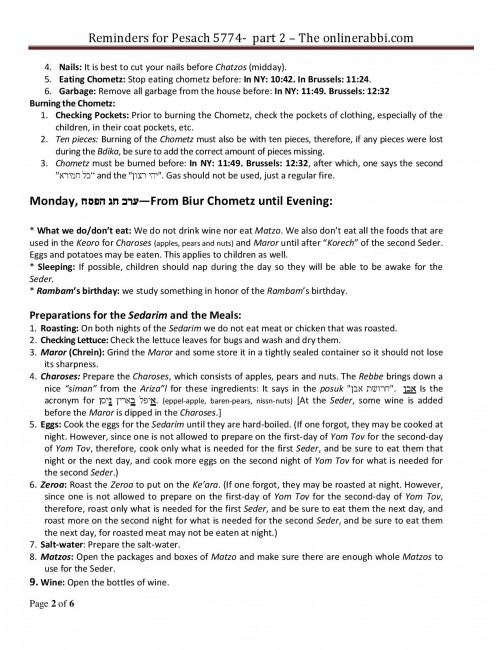
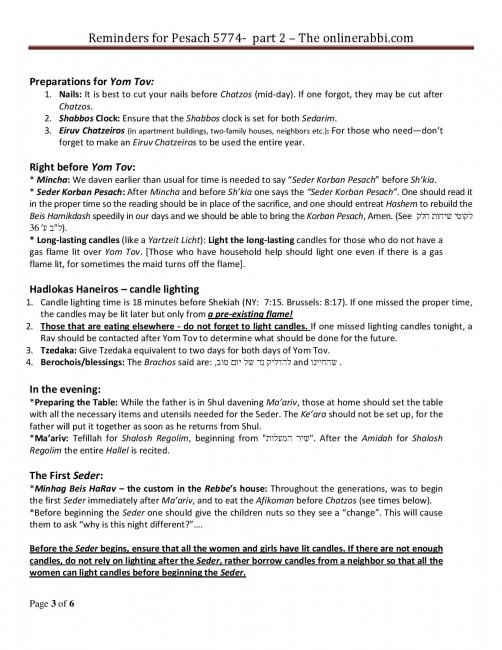
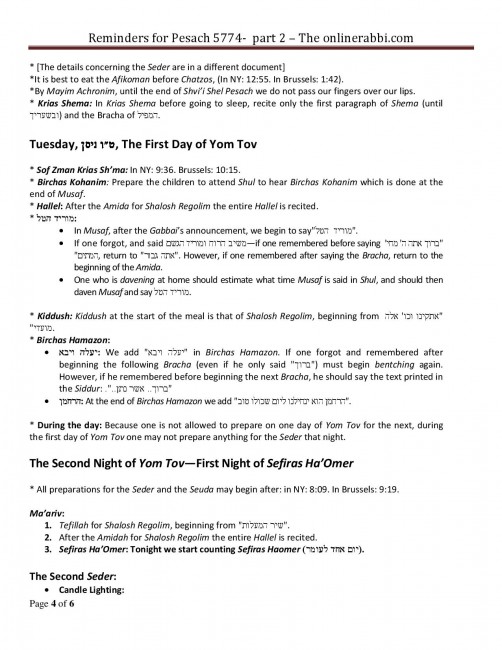
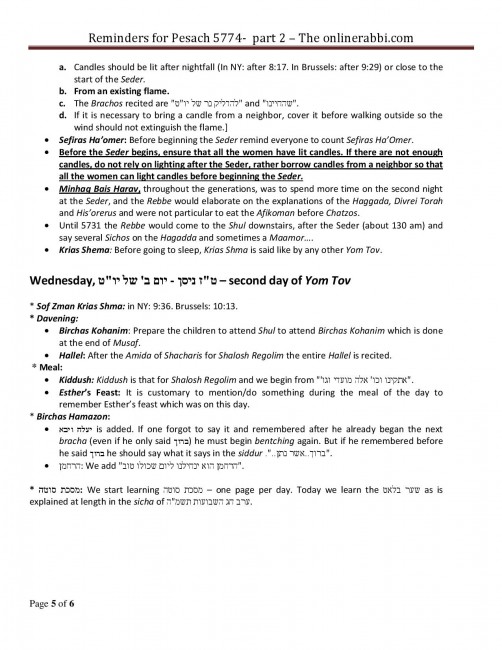













Melbourne Guide
here is the melbuorne guide:
https://dl.dropboxusercontent.com/u/89636247/YY/Pesach.pdf
Scale?
“Kizayis” is a shiur (measurement) in volume not weight.
Meir Z
You are correct and the volume size of a Kezayis is 2 Tablespoons or one fluid ounce (Lechumra for Matzah etc.) and 2/3 of a fluid ounce (Lekulah for Moror) but and a Revi’is is 6 Tablespoons or 3 fluid ounces.
Milhouse
This is true, but it’s very difficult to directly measure the volume of a solid object. If you know the object’s approximate density, then by far the easiest way to estimate its volume is to weigh it and divide the weight by that.
Arieh
In Part 1, Page 2, Point 10 where the author states “…those who are going away for Pesach and sell their home through the Rov…”. I believe he means to say to sell all the chometz in the home. Selling the home can lead to serious shailas even if the non-Jew never steps a foot in the house, for example; all the mezuzahs would have to be taken down after Pesach, checked and re-affixed with a Bracha, all the dishes and pots and utensils would require tevila, non-mevushal wine would have to be thrown out, etc…
Milhouse
Wrong. None of those consequences would result. The mezuzos and wine would be fine. There is nothing about a goy’s ownership that makes them possul. And for your informatoin we do sell the keilim, not just the chometz that’s absorbed in them, and when we buy them back we do not tovel them.
The obligation of tevilas keilim comes from the potential that the previous owner had to make a keli treif, even though he didn’t actually do so. The fact that a keili could have become treif gives it a sort of tum’ah, which must be removed. In our case, since the buyer never had physical access to the keilim, there was not even the potential for them to become treif, so there’s no need to tovel them.
Meir Z
To Mr. Milhouse: Can you please quote a source where it says that Tvilas Keilim has anything to do with Treif, as far as I know it has to do with transferring of ownership from a Goy to a Yid.
Though I do I do agree that according to Minhag Chabad we don’t Toivel the utensils after Pesach, nonetheless it is a matter of great debate amongst the Achronim.
Milhouse
Meir Z, see Shaarei Halocho uMinhog, OC vol 2 pp 101-102. The requirement for tevilah is created by the potential the keili had to become treif, regardless of whether it actually did so, just as the Midianite women were executed if they had the potential to have sinned, even if they didn’t do so. Keilim that were not under the goy’s physical control, so that it was never possible for them to become treif, don’t need tevilah.
Milhouse
Oops, only the two “potentials” should have been italicised.
Meir Z
Actually what the Rebbe says there is because the Goy in all cases of Mechiras Chometz does not actually use the Keilim – he does not write that the Goy doesn’t have the potential to use the Keilim (he actually does have the potential because he’s (supposed to be) given the key.
Question: does that mean that one who Kashers their Keilim that became Treif has to do Tevilas Keilim to them? And if no, why not? (Kal Vochomer: if Keilim that have the potential to become Treif (even if they didn’t) need Tevila, all the more so if they did become Treif!)
Milhouse
No, Meir Z, you have badly misread it. Go read it again. If you think about it for two seconds you will see that your reading is impossible According to your reading, we would not tovel new keilim!
If the goy actually used the keilim then they don’t just need tevilah, they need kashering!. And if he didn’t use them but they were in his possession, so he could have used them, they need tevilah, just as the Midianite girls over 3 had to be killed. That is why we have to dip new kelim that we buy from a goyisher store.
But in our case the goy was not able to use the keilim. We certainly do not give him any keys! If he wants to retrieve his property he has to knock on the door and be given access. Since he chose not to do so, the keilim never had the potential to become treif, just as the Midianite girls under 3 were not killed, because they had no connection to the aveira, even a potential one.
And yes, of course when you kasher keilim you have to tovel them as well. That is the original case the posuk is talking about, after all! We learn the whole law of tevilas keilim from the posuk that says the treife keilim looted from the Midianites needed to be kashered and toveled. Chazal explain that of course if the keili is new there’s no need to kasher it, because what would be the point? It’s already kosher! So we skip that step and go straight to the tevilah.